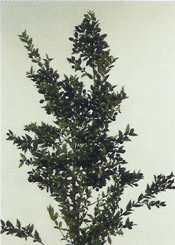

(Communis)
Myrtus
Nome Botanico: Myrtus Communis.
Famiglia: Myrtaceae.
Breve Descrizione: Ha portamento arbustivo o di piccolo alberello, alto da 50 a 300 cm, molto serrato. La corteccia è rossiccia nei rami giovani, col tempo assume un colore grigiastro. Ha foglie opposte, persistenti, ovali-acute, coriacee, glabre e lucide, di colore verde-scuro superiormente, a margine intero, con molti punti traslucidi in corrispondenza delle glandole aromatiche. I fiori sono solitari e ascellari, profumati, lungamente peduncolati, di colore bianco o roseo. Hanno simmetria raggiata, con calice gamosepalo persistente e corolla dialipetala. L'androceo è composto da numerosi stami ben evidenti per i lunghi filamenti. L'ovario è infero, suddiviso in 2-3 logge, terminante con uno stilo semplice, confuso fra gli stami e un piccolo stimma. La fioritura, abbondante, ha luogo nella tarda primavera e all'inizio dell'estate, da maggio a luglio. Un evento piuttosto frequente è la seconda fioritura che si può verificare in tarda estate, da agosto a settembre e, con autunni caldi, in ottobre. Il fenomeno è dovuto principalmente a fattori genetici. I frutti sono bacche globoso-ovoidali di colore nero-azzurrastro, rosso-scuro o più raramente biancastre, con numerosi semi reniformi. Maturano da novembre a gennaio persistendo per un lungo periodo sulla pianta.
Durata: Perenne.
Periodo Di Fioritura: Da giugno a luglio.
Area Di Origine: Europa, Asia.
Clima: Mediterraneo.
Uso: Ne esistono numerose varietà coltivate a scopo ornamentale come il Myrtus communis var. variegata alta fino a 4,50 m, con foglie dalle eleganti striature colorate di bianco-crema e fiori profumatissimi.
Botanical Name: Myrtus Communis.
Family: Myrtaceae.
Brief Description: He shrub or small tree, up from 50 to 300 cm, very tight. The bark is reddish in young branches, over time takes on a grayish color. Has opposite leaves, persistent, oval-acute, leathery, hairless and glossy, dark green above, entire margin, with many points in correspondence with translucent glands aromatic. The flowers are solitary and axillary, fragrant, long peduncles, white or pink. They have radial symmetry, with persistent calyx and corolla gamosepalo dialipetala. The androecium is composed of numerous stamens evident for long filaments. The ovary is inferior, divided into 2-3 loggias, ending with a stylus simple, confused between the stamens and a small stigma. Flowering, abundant, takes place in the late spring and early summer, from May to July. A rather frequent event is the second blooming that can occur in late summer, from August to September and, with warm autumns, in October. The phenomenon is mainly due to genetic factors. The fruits are berries globose-ovoid black-bluish, dark red or more rarely whitish, with numerous seeds reniform. Ripen from November to January persisting for a long time on the plant.
Duration: Perennial.
Flowering Period: From June to July.
Area of Origin: Europe, Asia.
Climate: Mediterranean.
Use: There are numerous varieties grown as ornamental as the Myrtus var. varied up to 4.50 m high, with leaves from the elegant colored streaks of creamy white and fragrant flowers.
FIORI RECISI / CUT FLOWERS (GEN-FEB-MAR)
FIORI RECISI / CUT FLOWERS (APR-MAG-GIU)
FIORI RECISI / CUT FLOWERS (LUG-AGO-SET)
FIORI RECISI / CUT FLOWERS (OTT-NOV-DIC)